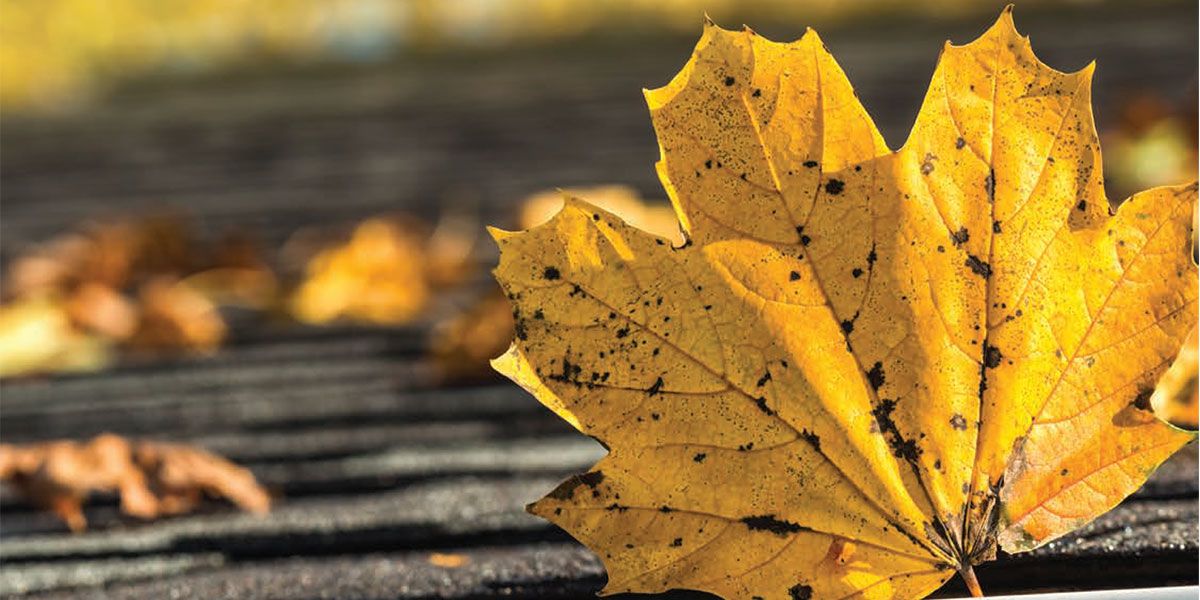YOUR FALL TO-DO LIST

8 ways to prep for colder weather
With the crisp mornings and colorful leaves of autumn upon us, it’s time to acknowledge the approach of winter. Whether you are mothballing a beach house after Labor Day or getting your primary residence ready for the cold season, winterizing your property is an important process. Start winterizing in early fall to accomplish DIY tasks in more pleasant weather and to get contractors scheduled before they are booked up for the season.
Here are several suggestions for a proper home winterization:
1. CLEAN OUT THE GUTTERS
Clogged gutters plus heavy rain or snow can lead to leaks that damage a home’s exterior and seep into wall insulation. Removing leaves, seed pods, twigs and other debris from gutters will likely require a ladder, which can be risky for do-it-yourselfers. Never stand on the top two to three steps of a ladder and work with someone on the ground to steady the base. A number of telescoping gutter wands for spraying out gutters are available; look for one with good reviews. Tip: Gutter cleaning contractors may be a good option to avoid ladders.
2. CHECK THE ATTIC FOR LEAKS
Now’s the time to make any repairs to your roof so that it will fend off rain or snow. Attic areas with missing or thin insulation can be bolstered with battens from a home improvement store. Insulating, whether DIY or contractor-installed, has a good return on investment. Tip: Be sure to wear gloves whenever you are handling fiberglass insulation.
3. INSPECT THE CHIMNEY
If you have a wood-burning fireplace, make sure the chimney is drawing properly before starting your first fire. Hire a chimney sweep to inspect for debris, soot buildup or nesting animals. Tip: This is a good time to test smoke and carbon monoxide detectors for proper operation.
4. WEATHERPROOF WINDOWS & DOORS
Cold air can migrate in through voids around windows and doors, especially older ones. Caulking, weatherstripping, door sweeps and even insulating window film are easy DIY fixes. Also, reverse any ceiling fans so they distribute warm air downward. Tip: To check for sources of drafts, hold a lit candle a couple of inches away from a window or door. Draft incursions will disrupt or even extinguish the flame.
5. PROTECT PIPES
We all know someone who’s experienced the costly inconvenience of a broken pipe and the resulting flooding. Homes that will be unattended during the winter need water systems shut down and drained in case power to the heating system is disrupted. Many savvy homeowners even close their home’s main water inlet anytime they will be away for a few days. Winterizing should also include outdoor faucets; shut off the valve just inside the wall if it is accessible. Remember that even “frostproof” outdoor faucets will freeze if a hose or outdoor watering timer is left connected to the spigot. Tip: If you do turn off the water supply valve, also turn off water heater(s) and water softener and whole-house filters to prevent damage or possible fire.
6. SERVICE THE HVAC
Replace your furnace filter and schedule a service inspection to make sure your heating system is ready to kick in as needed. HVAC contractors are in demand as winter approaches, so get your appointment scheduled early. Tip: Changing filters regularly helps ensure indoor air quality.
7. PREPARE YOUR PATIO & DECK
Cover patio furniture with weatherproof covers, or, if possible, store it away in a garage or shed. Keep it covered/stored until after pollen season. If your deck is wooden, a fresh coat of sealant will protect it in wet weather and leave it looking “ready” when spring arrives. Tip: Though some patio furniture (such as that made from teak) can stand up to wintery weather without being damaged, most wood and fabrics will last longer if protected from off-season elements.
8. HAVE SNOW REMOVAL TOOLS ON HAND
It’s better to locate and stage removal tools so that you’re not searching for them if snow does come. Spray snow shovels with silicone or other non-stick coating. Buy a bag of salt or sand to deal with slippery sidewalks, steps and porches. If you have a gas snow blower, make sure it has a full tank. Tip: Need new shovels or a snow blower? Save money by buying them ahead of winter.
When to call a pro
Winterizing a home can be a DIY project, but as with many home improvement projects, a professional can do it more quickly and easily. If you decide to prepare your home for winter on your own, allow yourself plenty of time before the cold weather arrives. If you discover any issues that could pose a hazard to yourself or your property, call in a professional right away so that you aren’t left out in the cold this winter. ✦
attic leaks, chimney, fall to-do list, gutters, hvac, patio & deck, pipes, snow removal tools, weatherproof














